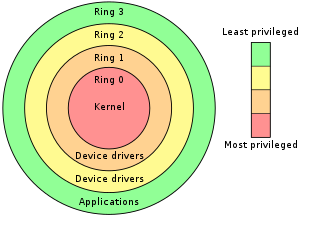Itanium is a family of 64-bit Intel microprocessors that implement the Intel Itanium architecture. Launched in June 2001, Intel marketed the processors for enterprise servers and high-performance computing systems. The Itanium architecture originated at Hewlett-Packard (HP), and was later jointly developed by HP and Intel.

Non-uniform memory access (NUMA) is a computer memory design used in multiprocessing, where the memory access time depends on the memory location relative to the processor. Under NUMA, a processor can access its own local memory faster than non-local memory. The benefits of NUMA are limited to particular workloads, notably on servers where the data is often associated strongly with certain tasks or users.

IA-64 is the instruction set architecture (ISA) of the Itanium family of 64-bit Intel microprocessors. The basic ISA specification originated at Hewlett-Packard (HP), and was evolved and then implemented in a new processor microarchitecture by Intel with HP's continued partnership and expertise on the underlying EPIC design concepts. In order to establish what was their first new ISA in 20 years and bring an entirely new product line to market, Intel made a massive investment in product definition, design, software development tools, OS, software industry partnerships, and marketing. To support this effort Intel created the largest design team in their history and a new marketing and industry enabling team completely separate from x86. The first Itanium processor, codenamed Merced, was released in 2001.

x86-64 is a 64-bit version of the x86 instruction set, first released in 1999. It introduced two new modes of operation, 64-bit mode and compatibility mode, along with a new 4-level paging mode.

Xeon is a brand of x86 microprocessors designed, manufactured, and marketed by Intel, targeted at the non-consumer workstation, server, and embedded system markets. It was introduced in June 1998. Xeon processors are based on the same architecture as regular desktop-grade CPUs, but have advanced features such as support for ECC memory, higher core counts, more PCI Express lanes, support for larger amounts of RAM, larger cache memory and extra provision for enterprise-grade reliability, availability and serviceability (RAS) features responsible for handling hardware exceptions through the Machine Check Architecture. They are often capable of safely continuing execution where a normal processor cannot due to these extra RAS features, depending on the type and severity of the machine-check exception (MCE). Some also support multi-socket systems with two, four, or eight sockets through use of the Quick Path Interconnect (QPI) bus.

Xserve is a line of rack unit computers designed by Apple Inc. for use as servers. Introduced in 2002, it was Apple's first designated server hardware design since the Apple Network Server in 1996. In the meantime, ordinary Power Macintosh G3 and G4 models were rebranded as Macintosh Server G3 and Macintosh Server G4 with some alterations to the hardware, such as added Gigabit Ethernet cards, UltraWide SCSI cards, extra large and fast hard drives etc. and shipped with Mac OS X Server software. The Xserve initially featured one or two PowerPC G4 processors, but later switched over to the then-new PowerPC G5, transitioned to Intel with the Core 2-based Xeon offerings and subsequently switched again to two quad-core Intel Nehalem microprocessors.

In computing, the Preboot eXecution Environment, PXE specification describes a standardized client–server environment that boots a software assembly, retrieved from a network, on PXE-enabled clients. On the client side it requires only a PXE-capable network interface controller (NIC), and uses a small set of industry-standard network protocols such as DHCP and TFTP.

Sun Fire is a series of server computers introduced in 2001 by Sun Microsystems. The Sun Fire branding coincided with the introduction of the UltraSPARC III processor, superseding the UltraSPARC II-based Sun Enterprise series. In 2003, Sun broadened the Sun Fire brand, introducing Sun Fire servers using the Intel Xeon processor. In 2004, these early Intel Xeon models were superseded by models powered by AMD Opteron processors. Also in 2004, Sun introduced Sun Fire servers powered by the UltraSPARC IV dual-core processor. In 2007, Sun again introduced Intel Xeon Sun Fire servers, while continuing to offer the AMD Opteron versions as well.

Windows IoT, formerly Windows Embedded, is a family of operating systems from Microsoft designed for use in embedded systems. Microsoft currently has three different subfamilies of operating systems for embedded devices targeting a wide market, ranging from small-footprint, real-time devices to point of sale (POS) devices like kiosks. Windows Embedded operating systems are available to original equipment manufacturers (OEMs), who make it available to end users preloaded with their hardware, in addition to volume license customers in some cases.

Intel Active Management Technology (AMT) is hardware and firmware for remote out-of-band management of select business computers, running on the Intel Management Engine, a separate microprocessor not exposed to the user, in order to monitor, maintain, update, upgrade, and repair them. Out-of-band (OOB) or hardware-based management is different from software-based management and software management agents.

The Platform Controller Hub (PCH) is a family of Intel's single-chip chipsets, first introduced in 2009. It is the successor to the Intel Hub Architecture, which used two chips - a northbridge and southbridge instead, and first appeared in the Intel 5 Series.

The Mac Mini is a SFF-class desktop computer made by Apple Inc. It is one of four desktop computers in the current Macintosh lineup, serving as an alternative to the all-in-one iMac, and sitting below the performance range iMac Pro and Mac Pro.

LGA 2011, also called Socket R, is a CPU socket by Intel. Released on November 14, 2011, it replaces Intel's LGA 1366 and LGA 1567 in the performance and high-end desktop and server platforms. The socket has 2011 protruding pins that touch contact points on the underside of the processor.
The Intel Modular Server System is a blade system manufactured by Intel using their own motherboards and processors. The Intel Modular Server System consists of an Intel Modular Server Chassis, up to six diskless Compute Blades, an integrated storage area network (SAN), and three to five Service Modules. The system was formally announced in January 2008. The server is aimed at small to medium businesses with "50 to 300 employees".

Ivy Bridge is the codename for the "third generation" of the Intel Core processors. Ivy Bridge is a die shrink to 22 nanometer manufacturing process based on the 32 nanometer Sandy Bridge —see tick–tock model. The name is also applied more broadly to the 22 nm die shrink of the Sandy Bridge microarchitecture based on FinFET ("3D") Tri-Gate transistors, which is also used in the Xeon and Core i7 Ivy Bridge-EX (Ivytown), Ivy Bridge-EP and Ivy Bridge-E microprocessors released in 2013.

The Intel Management Engine (ME), also known as the Intel Manageability Engine, is an autonomous subsystem that has been incorporated in virtually all of Intel's processor chipsets since 2008. It is located in the Platform Controller Hub of modern Intel motherboards.
Sunny Cove is a codename for a CPU microarchitecture developed by Intel, first released in September 2019. It succeeds the Palm Cove microarchitecture and is fabricated using Intel's 10 nm process node. The microarchitecture is implemented in 10th-generation Intel Core processors for mobile and third generation Xeon scalable server processors. 10th-generation Intel Core mobile processors were released in September 2019, while the Xeon server processors were released in April 6, 2021.













